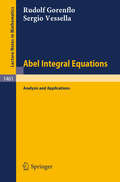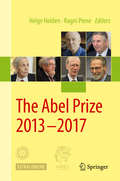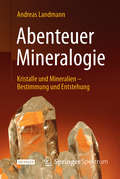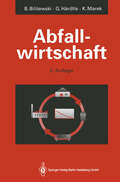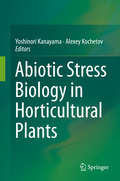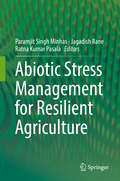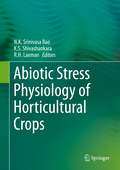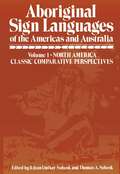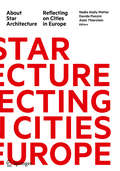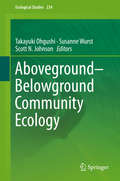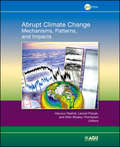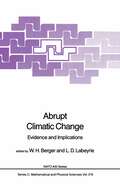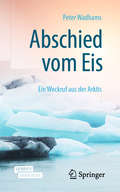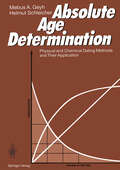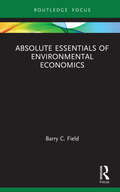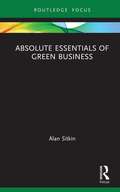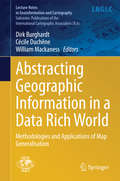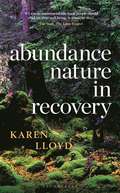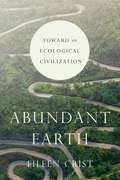- Table View
- List View
Abel Integral Equations: Analysis and Applications (Lecture Notes in Mathematics #1461)
by Rudolf Gorenflo Sergio VessellaIn many fields of application of mathematics, progress is crucially dependent on the good flow of information between (i) theoretical mathematicians looking for applications, (ii) mathematicians working in applications in need of theory, and (iii) scientists and engineers applying mathematical models and methods. The intention of this book is to stimulate this flow of information. In the first three chapters (accessible to third year students of mathematics and physics and to mathematically interested engineers) applications of Abel integral equations are surveyed broadly including determination of potentials, stereology, seismic travel times, spectroscopy, optical fibres. In subsequent chapters (requiring some background in functional analysis) mapping properties of Abel integral operators and their relation to other integral transforms in various function spaces are investi- gated, questions of existence and uniqueness of solutions of linear and nonlinear Abel integral equations are treated, and for equations of the first kind problems of ill-posedness are discussed. Finally, some numerical methods are described. In the theoretical parts, emphasis is put on the aspects relevant to applications.
The Abel Prize 2013-2017 (The Abel Prize)
by Helge Holden Ragni PieneThe book presents the winners of the Abel Prize in mathematics for the period 2013–17: Pierre Deligne (2013); Yakov G. Sinai (2014); John Nash Jr. and Louis Nirenberg (2015); Sir Andrew Wiles (2016); and Yves Meyer (2017). The profiles feature autobiographical information as well as a scholarly description of each mathematician’s work. In addition, each profile contains a Curriculum Vitae, a complete bibliography, and the full citation from the prize committee. The book also includes photos for the period 2003–2017 showing many of the additional activities connected with the Abel Prize. As an added feature, video interviews with the Laureates as well as videos from the prize ceremony are provided at an accompanying website (http://extras.springer.com/). This book follows on The Abel Prize: 2003-2007. The First Five Years (Springer, 2010) and The Abel Prize 2008-2012 (Springer 2014), which profile the work of the previous Abel Prize winners.
Abenteuer Mineralogie: Kristalle und Mineralien - Bestimmung und Entstehung
by Andreas LandmannDieses Buch führt Sie ein in die abenteuerliche Welt der Mineralien und Gesteine. In kaum einem naturwissenschaftlichen Feld können die Menschen so spannende Naturphänomene erleben wie in der Mineralogie. Die Urkräfte von Vulkanausbrüchen nehmen den Betrachter sofort gefangen. Das Funkeln von Edelsteinen, die seit Jahrmillionen im Erdinneren gewachsen sind, fasziniert Laien wie den Fachmann gleichermaßen. Alle Mineralien und Kristalle, die heute in Bergwerken und Steinbrüchen aus den Tiefen der Erde ans Tageslicht gelangen, sind älter als die gesamte Menschheitsgeschichte. Im vorliegenden Buch findet der Leser spannende Bilder von Mineralien, Edelsteinen und geologisch interessanten Orten, die der Autor als 350 Reisen besucht hat. Erlebnisse beim Mineraliensuchen geben dem Leser einen lebendigen Eindruck von Steinbrüchen und Bergwerken. Dazu wird anschaulich erklärt, wie die Kristalle zu ihren faszinierenden geometrischen Formen kommen. Für Sammler finden sich viele Mineralien- Bestimmungstipps. Mehr als 150 Bilder der wichtigsten Mineralien zeigen Ihnen die ganze Schönheit dieser Naturschätze.
Abfallwirtschaft: Eine Einführung
by Bernd Bilitewski Georg Härdtle Klaus MarekDas vollständige deutschsprachige Werk zum Thema Abfall, das alle Fragen der Umweltbeauftragten auf kommunaler Ebene beantwortet. Gleichzeitig eignet sich das Buch hervorragend als Lehrbuch für Fachhochschulen und Universitäten. In der zweiten Auflage wurden auch abgesicherte Erfahrungen aus den neuen Bundesländern ausgewertet. Vor allem die Diskussion um das Duale System wird mit diesem Werk auf eine solide Basis gestellt.
Abiotic Stress Biology in Horticultural Plants
by Yoshinori Kanayama Alexey KochetovThe purpose of this publication is to elucidate the biological aspect of the abiotic stress response from the field to the molecular level in horticultural plants. This book is unique in that it concerns the basic aspect of abiotic stress biology and research progress at the molecular level in model plants or major field crops, as it focuses mainly on the abiotic stress response in existing horticultural plants. Many readers interested in plant abiotic stress biology are aware of the application of the latest findings to agricultural production, and this book will have a special appeal for those readers. The book will be of interest to scientists and graduate students who are involved in the research, development, production, processing, and marketing of horticultural products, including those in developing countries who are interested in high tech and advanced science in this field. The application of the latest findings to agricultural production is particularly useful.Stress tolerance mechanisms in horticultural crops are gaining importance, because most agricultural regions are predicted to experience considerably more extreme environmental fluctuations due to global climate change. Further, because of recent progress in next-generation sequencing technologies, the postgenomic era is impending not only in model plants and major cereal crops but also in horticultural crops, which comprise a great diversity of species. This book provides information on the physiological aspects of the abiotic stress response in horticultural plants, which is considered essential for postgenomic research.
Abiotic Stress Management for Resilient Agriculture
by Paramjit Singh Minhas Jagadish Rane Ratna Kumar PasalaThis book offers a state-of-the-art overview of on abiotic stresses in terms of the challenges; scope and opportunities; copping strategies for adaptation and mitigation using novel tools for building resilience in agricultural crops and livestock; as well as for policy implementation. Divided into four major parts: advances and prospects for understanding stress environments; adaptation and mitigation options; crop-based mitigation strategies; and mitigation options in animal husbandry, the book focuses on problem-solving approaches and techniques that are essential for the medium to long-term sustainability of agricultural production systems The synthesis and integration of knowledge and experiences of specialists from different disciplines offers new perspectives in the versatile field of abiotic stress management, and as such is useful for various stakeholders, including agricultural students, scientists, environmentalists, policymakers, and social scientists.
Abiotic Stress Physiology of Horticultural Crops
by N.K. Srinivasa Rao K. S. Shivashankara R. H. LaxmanThis book brings together recent advances in the area of abiotic stress tolerance in various vegetables, fruit crops, plantation crops and tuber crops. The main challenges to improving the productivity of horticultural crops are the different types of abiotic stresses generally caused by climate change at the regional and global level. Heat, drought, cold and salinity are the major abiotic stresses that adversely affect growth and productivity and can trigger a series of morphological, physiological, biochemical and molecular changes in various horticultural crops. To date, there are no books covering horticultural crop-specific abiotic stress tolerance mechanisms and their management. Addressing that gap, the book is divided into 2 sections, the first of which highlights recent advances in the general aspects of abiotic stress tolerance like the role of hormones, reactive oxygen species, seed treatments, molecular mechanisms of heat tolerance and heavy metal toxicity, while the second focuses on the abiotic stress tolerance mechanisms of various vegetables, fruit crops, plantation crops and tuber crops. It includes comprehensive discussions of fruit crops like mango, grapes, banana, litchi and arid zone fruits; vegetables crops like tomato, capsicum, onion and tuber crops; and plantation crops like coconut, areca nut, oil palm and black pepper. Among the strategies for plant stress survival, examples of both avoidance and tolerance relevant to particular crops are examined in detail, supported by selected comprehensive case studies of progress. As such, the book offers a valuable resource suited for scientists and graduate students working in the fields of crop improvement, genetic engineering, and the abiotic stress tolerance of horticultural crops.
Aboriginal Sign Languages of The Americas and Australia: Volume 1; North America Classic Comparative Perspectives
by D. Umiker-Sebeok1. THE SEMIOTIC CHARACTER OF ABORIGINAL SIGN LANGUAGES In our culture, language, especially in its spoken manifestation, is the much vaunted hallmark of humanity, the diagnostic trait of man that has made possible the creation of a civilization unknown to any other terrestrial organism. Through our inheritance of a /aculte du langage, culture is in a sense bred inta man. And yet, language is viewed as a force wh ich can destroy us through its potential for objectification and classification. According to popular mythology, the naming of the animals of Eden, while giving Adam and Eve a certain power over nature, also destroyed the prelinguistic harmony between them and the rest of the natural world and contributed to their eventual expulsion from paradise. Later, the post-Babel development of diverse language families isolated man from man as weIl as from nature (Steiner 1975). Language, in other words, as the central force animating human culture, is both our salvation and damnation. Our constant war with words (Shands 1971) is waged on both internal and external battlegrounds. This culturally determined ambivalence toward language is particularly appar ent when we encounter humans or hominoid animals who, for one reason or another, must rely upon gestural forms of communication.
About Star Architecture: Reflecting on Cities in Europe
by Davide Ponzini Alain Thierstein Nadia Alaily-MattarCities across the world have been resorting to star architects to brand their projects, spark urban regeneration and market the city image internationally. This book shifts the attention from star architects to star architecture, arguing that the process of deciding about and implementing relevant architectural and urban projects is not the product of any single actor. Star architecture can, in fact, be better studied and understood as assembled by multiple actors and in its relationship with urban transformation. In its 18 chapters, the book presents a multidisciplinary collection of expert contributions in the fields of urban planning, architecture, media studies, urban economics, geography, and sociology, consistently brought together for the first time to deal with this topic. Through a vast array of case studies and analytical techniques touching over 20 cities in Europe, the book shows the positive and more problematic impacts of star architecture with reference to the preservation of built heritage, tourism and media. The book will be of interest to architects, sociologists, urban planners, and public administrators.
Aboveground–Belowground Community Ecology (Ecological Studies #234)
by Takayuki Ohgushi Susanne Wurst Scott N. JohnsonResearchers now recognize that above- and belowground communities are indirectly linked to one another, often by plant-mediated mechanisms. To date, however, there has been no single multi-authored edited volume on the subject. This book remedies that gap, and offers state-of-the art insights into basic and applied research on aboveground-belowground interactions and their functional consequences. Drawing on a diverse pool of global expertise, the authors present diverse approaches that span a range of scales and levels of complexity.The respective chapters provide in-depth information on the current state of research, and outline future prospects in the field of aboveground-belowground community ecology. In particular, the book’s goal is to expand readers’ knowledge of the evolutionary, community and ecosystem consequences of aboveground-belowground interactions, making it essential reading for all biologists, graduate students and advanced undergraduates working in this rapidly expanding field. It touches on multiple research fields including ecology, botany, zoology, entomology, microbiology and the related applied areas of biodiversity management and conservation.
Abrupt Climate Change: Mechanisms, Patterns, and Impacts (Geophysical Monograph Series #193)
by Harunur Rashid Leonid Polyak Ellen Mosley-ThompsonPublished by the American Geophysical Union as part of the Geophysical Monograph Series, Volume 193.Abrupt Climate Change: Mechanisms, Patterns, and Impacts brings together a diverse group of paleoproxy records such as ice cores, marine sediments, terrestrial (lakes and speleothems) archives, and coupled ocean-atmosphere climate models to document recent advances in understanding the mechanisms of abrupt climate changes. Since the discovery of the Dansgaard-Oeschger events in Greenland ice cores and the subsequent discovery of their contemporary events in the marine sediments of the North Atlantic, the search for these abrupt, millennial-scale events across the globe has intensified, and as a result, the number of paleoclimatic records chronicling such events has increased. The volume highlights include discussions of records of past climate variability, meridional overturning circulation, land-ocean-atmosphere interactions, feedbacks in the climate system, and global temperature anomalies. Abrupt Climate Change will be of interest to students, researchers, academics, and policy makers who are concerned about abrupt climate change and its potential impact on society.
Abrupt Climate Change: Mechanisms, Patterns, and Impacts (Geophysical Monograph Series #193)
by Harunur Rashid Leonid Polyak Ellen Mosley-ThompsonPublished by the American Geophysical Union as part of the Geophysical Monograph Series, Volume 193.Abrupt Climate Change: Mechanisms, Patterns, and Impacts brings together a diverse group of paleoproxy records such as ice cores, marine sediments, terrestrial (lakes and speleothems) archives, and coupled ocean-atmosphere climate models to document recent advances in understanding the mechanisms of abrupt climate changes. Since the discovery of the Dansgaard-Oeschger events in Greenland ice cores and the subsequent discovery of their contemporary events in the marine sediments of the North Atlantic, the search for these abrupt, millennial-scale events across the globe has intensified, and as a result, the number of paleoclimatic records chronicling such events has increased. The volume highlights include discussions of records of past climate variability, meridional overturning circulation, land-ocean-atmosphere interactions, feedbacks in the climate system, and global temperature anomalies. Abrupt Climate Change will be of interest to students, researchers, academics, and policy makers who are concerned about abrupt climate change and its potential impact on society.
Abrupt Climatic Change: Evidence and Implications (Nato Science Series C: #216)
by W. H. Berger L. D. LabeyrieProceedings of the NATO Advanced Research Workshop, St. Hugues de Biviers, France, October 16-22, 1985
Abschied vom Eis: Ein Weckruf aus der Arktis
by Peter WadhamsDas Meereis der Polargebiete ist nicht nur wunderschön, es reguliert auch die Temperatur der Erde. Doch es zieht sich zurück – und zwar schnell! Dabei laufen komplexe Rückkopplungen ab, die das Potenzial haben, den Klimawandel zu beschleunigen und zu verstärken. Der britische Polarforscher Peter Wadhams ist einer der international führenden Meereisexperten. Er greift auf seine fast lebenslange Forschung in der Arktis zurück, um zu erklären, was gerade passiert, was das für unsere Zukunft bedeutet – und was wir tun können und müssen.Der AutorPeter Wadhams ist einer der weltweit erfahrensten Polar- und Meereisforscher. Er war von 1987–92 Direktor des Scott Polar Institute in Cambridge und dort auch von 1992–2015 Professor für Physik der Ozeane. Er war an mehr als 50 Expeditionen in beide Polarregionen beteiligt – in Forschungscamps, auf Eisbrechern, von Flugzeugen aus, und sogar in Unterseebooten. Er wurde ausgezeichnet mit dem W. S. Bruce-Preis der Royal Society of Edinburgh (1977), der UK Polar Medal (1987) und dem Italgas-Preis für Umweltwissenschaften (1990). Er ist Fellow der Royal Geographical Society und Mitglied der Finnischen Akademie.
Absolute Age Determination: Physical and Chemical Dating Methods and Their Application
by Mebus A. Geyh Helmut SchleicherWith the growing recognition during the last two centuries that the Earth has an immense age and processes over long periods of time have changed the morphology and composition of the Earth's crust, geologists have become increasingly interested in determination of absolute ages. A rela tive geochronology was established on the basis of the lithostratigraphic and biostratigraphic principles developed during the last century. With the discovery of radioactivity, the basis for a new geoscientific discipline - geochronology - was established (Rutherford 1906). It is the study of geological time, based mainly on the time signatures provided by the isotopic composition in geologic materials. The isotopic signature in a rock yields more information than that provided by the geochemical signature alone because it reflects the origin and history of the element in the rock. The aim of geochronology is to calibrate and standardize chronostrati graphic scales, to develop geological time scales that have a sensitive or at least useful resolution in order to place the geological events in the correct chronological order, and to assign their proper time spans. In practice, the application of geochronology is much wider because the data in the "natural archives" often provide information on the origin, genesis, and history of the materials. This, of course, requires an understanding of the geochemical behavior of the substances involved.
Absolute Essentials of Environmental Economics (Absolute Essentials of Business and Economics)
by Barry C. FieldThis shortform textbook provides a concise overview of the fundamentals of environmental economics. It focuses on how economic forces affect the natural environment and how economic policies and behaviors may be altered to improve environmental quality. Spanning ten chapters, the book introduces readers to the key ideas in environmental economics. Topics include environmental externalities, technological change, cost-benefit analysis, pollution charges, emissions and offset trading, climate change, and public policy. Written by an established educator and scholar, Absolute Essentials of Environmental Economics will be valuable reading for students of environmental economics, environmental policy, environmental management and related areas. People affiliated with environmental interest groups, "think tanks," and advocacy groups will also find it beneficial.
Absolute Essentials of Environmental Economics (Absolute Essentials of Business and Economics)
by Barry C. FieldThis shortform textbook provides a concise overview of the fundamentals of environmental economics. It focuses on how economic forces affect the natural environment and how economic policies and behaviors may be altered to improve environmental quality. Spanning ten chapters, the book introduces readers to the key ideas in environmental economics. Topics include environmental externalities, technological change, cost-benefit analysis, pollution charges, emissions and offset trading, climate change, and public policy. Written by an established educator and scholar, Absolute Essentials of Environmental Economics will be valuable reading for students of environmental economics, environmental policy, environmental management and related areas. People affiliated with environmental interest groups, "think tanks," and advocacy groups will also find it beneficial.
Absolute Essentials of Green Business (Absolute Essentials of Business and Economics)
by Alan SitkinThis short textbook provides a core understanding of the intersection between business and the natural environment. The sector’s rapid expansion means that many university programmes are focusing to a greater extent nowadays on the career opportunities generated by the ecological imperative – a curriculum increasingly referred to as "green business". Climate breakdown is a devastating issue facing contemporary society. With six out of the ten largest multinationals listed in the 2018 Fortune Global 500 being active in the energy sector, it is no surprise that more and more business schools are offering modules addressing the management of natural resources. The business world has made some progress incorporating green principles into their strategies and operations, but progress needs to accelerate in line with global agreements to prevent catastrophic ecological and environmental problems. Absolute Essentials of Green Business stands out because of its singular focus on a subset of this wider curricular area. By covering both the macro (framework) and micro (business strategy) aspects of the topic, the book’s structure is in line with the way modules of this nature are taught in universities today. Students of business and environmental studies will benefit from reading this concise textbook in order to develop their understanding of a fundamental element of the social science curriculum.
Absolute Essentials of Green Business (Absolute Essentials of Business and Economics)
by Alan SitkinThis short textbook provides a core understanding of the intersection between business and the natural environment. The sector’s rapid expansion means that many university programmes are focusing to a greater extent nowadays on the career opportunities generated by the ecological imperative – a curriculum increasingly referred to as "green business". Climate breakdown is a devastating issue facing contemporary society. With six out of the ten largest multinationals listed in the 2018 Fortune Global 500 being active in the energy sector, it is no surprise that more and more business schools are offering modules addressing the management of natural resources. The business world has made some progress incorporating green principles into their strategies and operations, but progress needs to accelerate in line with global agreements to prevent catastrophic ecological and environmental problems. Absolute Essentials of Green Business stands out because of its singular focus on a subset of this wider curricular area. By covering both the macro (framework) and micro (business strategy) aspects of the topic, the book’s structure is in line with the way modules of this nature are taught in universities today. Students of business and environmental studies will benefit from reading this concise textbook in order to develop their understanding of a fundamental element of the social science curriculum.
Abstracting Geographic Information in a Data Rich World: Methodologies and Applications of Map Generalisation (Lecture Notes in Geoinformation and Cartography)
by Dirk Burghardt Cécile Duchêne William MackanessResearch in the field of automated generalisation has faced new challenges in recent years as a result of technological developments in web-based processing, new visualisation paradigms and access to very large volumes of multi-source data generated by sensors and humans. In these contexts, map generalisation needs to underpin ‘on-demand mapping’, a form of mapping that responds to individual user requirements in the thematic selection and visualisation of geographic information. It is this new impetus that drives the research of the ICA Commission on Generalisation and Multiple Representation (for example through its annual workshops, biannual tutorials and publications in international journals). This book has a coherent structure, each chapter focusing on core concepts and tasks in the map generalisation towards on-demand mapping. Each chapter presents a state-of-the-art review, together with case studies that illustrate the application of pertinent generalisation methodologies. The book addresses issues from data gathering to multi scaled outputs. Thus there are chapters devoted to defining user requirements in handling specifications, and in the application and evaluation of map generalisation algorithms. It explores the application of generalisation methodologies in the context of growing volumes of data and the increasing popularity of user generated content.
Abundance: Nature in Recovery
by Karen LloydIn this collection of literary essays, Karen Lloyd explores abundance and loss in the natural world, relating compelling stories of restoration, renewal and repair, describing how those working on the front lines of conservation are challenging the inevitability of biodiversity loss, as well as navigating her own explorations of the meaning of abundance in the Anthropocene. In an era of urgent ecological challenge, her timely book reveals the places that people are coming together to bring species and habitats back from the edge of extinction. Yet, elsewhere, many other species are being allowed to disappear forever. To understand why, she examines how humans have chosen to entangle themselves in nature and considers the ways we perceive the natural world. A book about ways of seeing, as Lloyd explores attitudes towards meaningful restoration, she weaves her insightful and joyous narrative through a diverse range of inspiring landscapes, from Romania's Carpathian mountains and the Hungarian Steppe to Perthshire's rivers and the dune forests of the Netherlands.
Abundance: Nature in Recovery
by Karen LloydIn this collection of literary essays, Karen Lloyd explores abundance and loss in the natural world, relating compelling stories of restoration, renewal and repair, describing how those working on the front lines of conservation are challenging the inevitability of biodiversity loss, as well as navigating her own explorations of the meaning of abundance in the Anthropocene. In an era of urgent ecological challenge, her timely book reveals the places that people are coming together to bring species and habitats back from the edge of extinction. Yet, elsewhere, many other species are being allowed to disappear forever. To understand why, she examines how humans have chosen to entangle themselves in nature and considers the ways we perceive the natural world. A book about ways of seeing, as Lloyd explores attitudes towards meaningful restoration, she weaves her insightful and joyous narrative through a diverse range of inspiring landscapes, from Romania's Carpathian mountains and the Hungarian Steppe to Perthshire's rivers and the dune forests of the Netherlands.
Abundant Earth: Toward an Ecological Civilization
by Eileen CristIn Abundant Earth, Eileen Crist not only documents the rising tide of biodiversity loss, but also lays out the drivers of this wholesale destruction and how we can push past them. Looking beyond the familiar litany of causes—a large and growing human population, rising livestock numbers, expanding economies and international trade, and spreading infrastructures and incursions upon wildlands—she asks the key question: if we know human expansionism is to blame for this ecological crisis, why are we not taking the needed steps to halt our expansionism? Crist argues that to do so would require a two-pronged approach. Scaling down calls upon us to lower the global human population while working within a human-rights framework, to deindustrialize food production, and to localize economies and contract global trade. Pulling back calls upon us to free, restore, reconnect, and rewild vast terrestrial and marine ecosystems. However, the pervasive worldview of human supremacy—the conviction that humans are superior to all other life-forms and entitled to use these life-forms and their habitats—normalizes and promotes humanity’s ongoing expansion, undermining our ability to enact these linked strategies and preempt the mounting suffering and dislocation of both humans and nonhumans. Abundant Earth urges us to confront the reality that humanity will not advance by entrenching its domination over the biosphere. On the contrary, we will stagnate in the identity of nature-colonizer and decline into conflict as we vie for natural resources. Instead, we must chart another course, choosing to live in fellowship within the vibrant ecologies of our wild and domestic cohorts, and enfolding human inhabitation within the rich expanse of a biodiverse, living planet.
Abundant Earth: Toward an Ecological Civilization
by Eileen CristIn Abundant Earth, Eileen Crist not only documents the rising tide of biodiversity loss, but also lays out the drivers of this wholesale destruction and how we can push past them. Looking beyond the familiar litany of causes—a large and growing human population, rising livestock numbers, expanding economies and international trade, and spreading infrastructures and incursions upon wildlands—she asks the key question: if we know human expansionism is to blame for this ecological crisis, why are we not taking the needed steps to halt our expansionism? Crist argues that to do so would require a two-pronged approach. Scaling down calls upon us to lower the global human population while working within a human-rights framework, to deindustrialize food production, and to localize economies and contract global trade. Pulling back calls upon us to free, restore, reconnect, and rewild vast terrestrial and marine ecosystems. However, the pervasive worldview of human supremacy—the conviction that humans are superior to all other life-forms and entitled to use these life-forms and their habitats—normalizes and promotes humanity’s ongoing expansion, undermining our ability to enact these linked strategies and preempt the mounting suffering and dislocation of both humans and nonhumans. Abundant Earth urges us to confront the reality that humanity will not advance by entrenching its domination over the biosphere. On the contrary, we will stagnate in the identity of nature-colonizer and decline into conflict as we vie for natural resources. Instead, we must chart another course, choosing to live in fellowship within the vibrant ecologies of our wild and domestic cohorts, and enfolding human inhabitation within the rich expanse of a biodiverse, living planet.
Abundant Earth: Toward an Ecological Civilization
by Eileen CristIn Abundant Earth, Eileen Crist not only documents the rising tide of biodiversity loss, but also lays out the drivers of this wholesale destruction and how we can push past them. Looking beyond the familiar litany of causes—a large and growing human population, rising livestock numbers, expanding economies and international trade, and spreading infrastructures and incursions upon wildlands—she asks the key question: if we know human expansionism is to blame for this ecological crisis, why are we not taking the needed steps to halt our expansionism? Crist argues that to do so would require a two-pronged approach. Scaling down calls upon us to lower the global human population while working within a human-rights framework, to deindustrialize food production, and to localize economies and contract global trade. Pulling back calls upon us to free, restore, reconnect, and rewild vast terrestrial and marine ecosystems. However, the pervasive worldview of human supremacy—the conviction that humans are superior to all other life-forms and entitled to use these life-forms and their habitats—normalizes and promotes humanity’s ongoing expansion, undermining our ability to enact these linked strategies and preempt the mounting suffering and dislocation of both humans and nonhumans. Abundant Earth urges us to confront the reality that humanity will not advance by entrenching its domination over the biosphere. On the contrary, we will stagnate in the identity of nature-colonizer and decline into conflict as we vie for natural resources. Instead, we must chart another course, choosing to live in fellowship within the vibrant ecologies of our wild and domestic cohorts, and enfolding human inhabitation within the rich expanse of a biodiverse, living planet.
